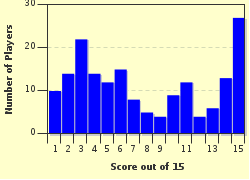Quiz Answer Key and Fun Facts
1. In 1333, the followers of the Emperor Go-Daigo destroyed the Kamakura Bakufu (Sh˘gunate). In the years to come, one of them, Ashikaga Takauji, would drive Go-Daigo out of Ky˘to and establish a new Bakufu ruled by his own family. This new Sh˘gunate is known to history as what?
2. Although Go-Daigo had been driven out of Ky˘to, he still commanded the loyalty of powerful warriors such as Nitta Yoshisada and Kusunoki Masashige. However, they were defeated by the Ashikaga in 1336, at which battle?
3. After Go-Daigo had fled Ky˘to, the Ashikaga attempted to proceed as if he had been deposed, appointing a new Emperor, K˘my˘. However, Go-Daigo had other ideas and, from his base in modern-day Nara Prefecture, proclaimed that he was still the legitimate Emperor. Thus began a period in which Japan had two rival Imperial courts. What were the two courts called?
4. The third Ashikaga Sh˘gun, Ashikaga Yoshimitsu, oversaw a period of peace and artistic flowering. He also re-established the long-defunct links between Japan and China. Which of the following policies did he NOT adopt in his efforts to improve relations with the new Ming Dynasty?
5. The Ashikaga Sh˘guns began to rely on Constables (Shugo) to administer the provinces for them. Over time, the Shugo developed into powerful lords in their own right, becoming semi-independent in their provincial strongholds. What well-known word eventually came to describe them?
6. In 1467 began the ďnin War, a struggle between Shugo whose power now rivaled that of the Ashikaga. There had been similar conflicts between such warlords before, but what was different about the ďnin War?
7. After the ďnin War, Ashikaga control collapsed and Japan entered a long era of disunity in which rival warlords competed for power. What is this period called?
8. During this period, followers of the J˘d˘-shinshű Buddhist sect began to rise up in spontaneous acts of rebellion against samurai rule. What were these movements called?
9. During the period of civil war, there was a famous rivalry between two great warlords, who over the years fought five major battles on the plain of Kawanakajima. What were their names?
10. The unification of the country finally began in the mid-sixteenth century with the rise of the warlord Oda Nobunaga. Of which province was he the Daimy˘?
11. Oda Nobunaga was the first of the three great unifiers of Japan. The other two, Toyotomi Hideyoshi and Tokugawa Ieyasu, were both closely connected to him. How were they connected?
12. After Nobunaga was assassinated in 1582, Hideyoshi and Ieyasu were the obvious candidates to succeed him. Hideyoshi, in the more powerful position, suggested that Ieyasu instead relocate to the eastern provinces and take over a vast domain there. Ieyasu accepted, establishing his headquarters at a small fishing village in the east. The village was then called Edo; it is now called...
13. After Nobunaga's death, Hideyoshi completed the unification of the country, and subdued or appeased all the powerful Daimy˘. How did he follow up this success?
14. When Hideyoshi died, his son Hideyori was still an infant. The most powerful of Hideyoshi's allies acted as regents to the young heir. Tokugawa Ieyasu, the most powerful of all, soon began to dominate and opposition to him coalesced. The two sides met in 1600 at the most significant battle in the history of Japan. What is it called?
15. After winning the battle, Ieyasu was the master of Japan. However, he did not move to destroy Toyotomi Hideyori, Hideyoshi's son, until 1615, when he finally wiped out the remnants of the Toyotomi in their home base. Which modern-day Japanese city was the HQ of the Toyotomi?
Source: Author
Finduskeepus
This quiz was reviewed by FunTrivia editor
bloomsby before going online.
Any errors found in FunTrivia content are routinely corrected through our feedback system.

